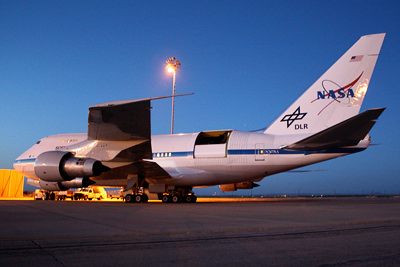[/caption]
From the Cornell University Chronicle, written by Lauren Gold:
The SOFIA project has been in the making for more than 13 years — but the airplane has an even longer history. Originally owned by Pan Am, the 747SP (Special Performance) was named the Clipper Lindbergh and christened by Anne Morrow Lindbergh in 1977 on the 50th anniversary of Lindbergh’s flight across the Atlantic.
The Boeing 747SP differs from a modern 747 in a few ways. Most notably, it’s 45 feet shorter and, thus, lighter — which allowed it to make long transoceanic flights without stopping to refuel. (Modern 747s have much more efficient engines.)
The plane already had two Cornell connections long before astronomy professor and principal investigator Terry Herter and his team installed FORCAST onto the telescope in February.
When Boeing was designing the plane in the 1970s, they hired a young Cornell mechanical engineering graduate to design its horizontal stabilizer (which allows the pilot to raise or lower the nose of the plane in flight). That engineer, Bill Nye ’77, eventually went on to become “Bill Nye the Science Guy” — the Emmy Award-winning science educator and Cornell Frank H.T. Rhodes Class of 1956 Professor from 2001 to 2006.
A decade later in 1989, when the plane was in commercial service, George Gull, Cornell research support specialist and now lead engineer for FORCAST, just happened to notice the “Clipper Lindbergh” insignia on his plane when he flew from Hong Kong to San Francisco after a Cornell Glee Club trip to China.
So while Gull won’t be one of the lucky few on the plane for the May 25 first light flight — he can boast having flown on the plane 21 years before everyone else on the team.
Since NASA bought the Clipper Lindbergh in 1997, SOFIA has undergone more than a few changes. Among many other things, it has a 16-by-23-foot door cut into the port side for the telescope and a bump near the rear of the plane that smoothes out airflow around the fuselage when the telescope door is open.
Currently, a grid of what looks like hundreds of small dots — actually pieces of yarn — cover the surface of the telescope door and the area around it. The yarn is a low-tech but effective way of optimizing aerodynamics — researchers flying alongside SOFIA in a chase plane videotape the yarn’s motion to analyze air flow around the door. The yarn will be removed when the observatory goes into regular operation.
Inside, the plane has a few remnants of its past: several original seats; the spiral staircase to the upper deck; an array of analog instruments in the cockpit. But most of the seats are a hodgepodge of military airplane seats at workstations, facing backward toward the massive, 17-ton telescope and instruments.
The cabin also includes an area for educators and reporters who will take part in flights as part of the mission’s effort to educate and engage the public. And the telescope itself is part of a pressure bulkhead that allows the main cabin to stay pressurized despite the open door behind it.
Despite its novelty, SOFIA follows a long history of airborne astronomy that started with observations made from biplanes in the 1920s and ’30s. Most recently, NASA’s Kuiper Airborne Observatory, a modified Lockheed C-141 with a 1-meter infrared telescope that operated 1974-95, was the vehicle for discoveries including the rings around Uranus, the atmosphere around Pluto and the presence of water vapor in the interstellar medium.
Source: Cornell


It will be good to see that this on again – off again project finally do some science!
This project is not only a NASA project.
Note the slightly smaller DLR logo. Thats right, the Germans are involved 🙂
I agree with Aqua. I was dissapointed to initially hear that this project was going to get the axe when NASA didn’t know what it wanted to do with itself as budgets were being cut. Ditto for the SIM mission, which eventually became SIM Lite.
I really whonder how much money is being saved by these types of knee jerk reactions?